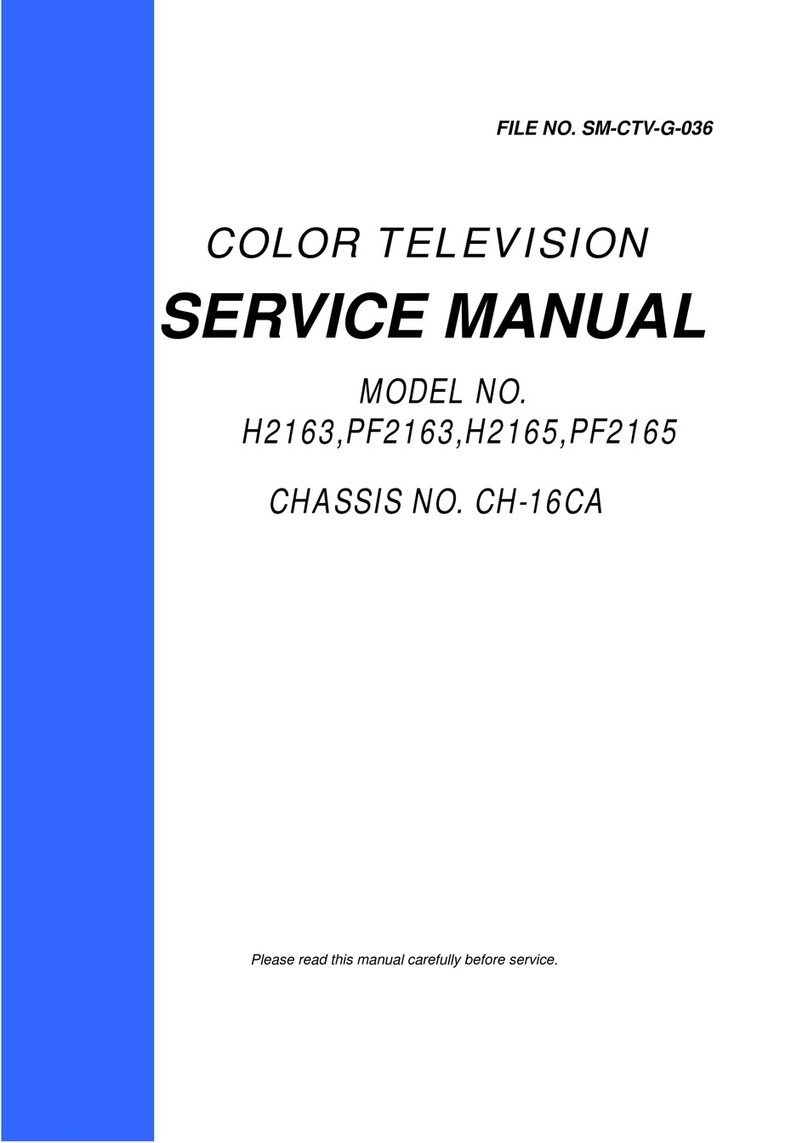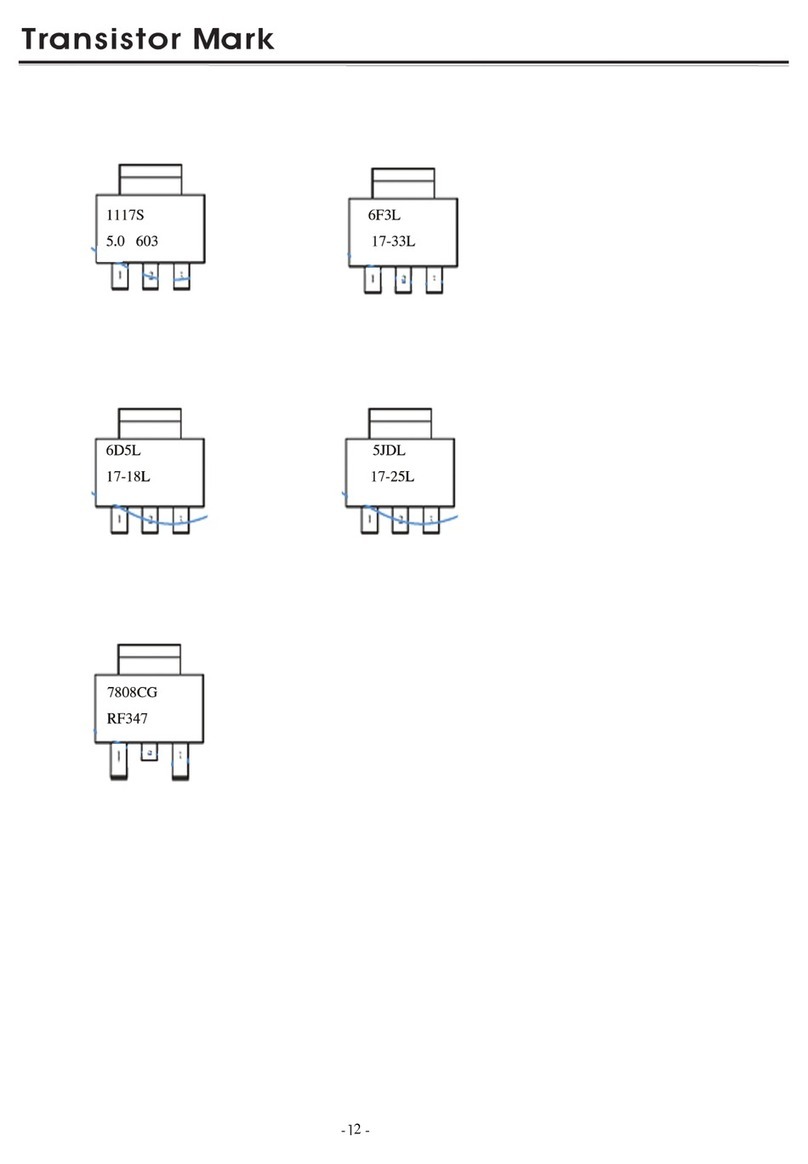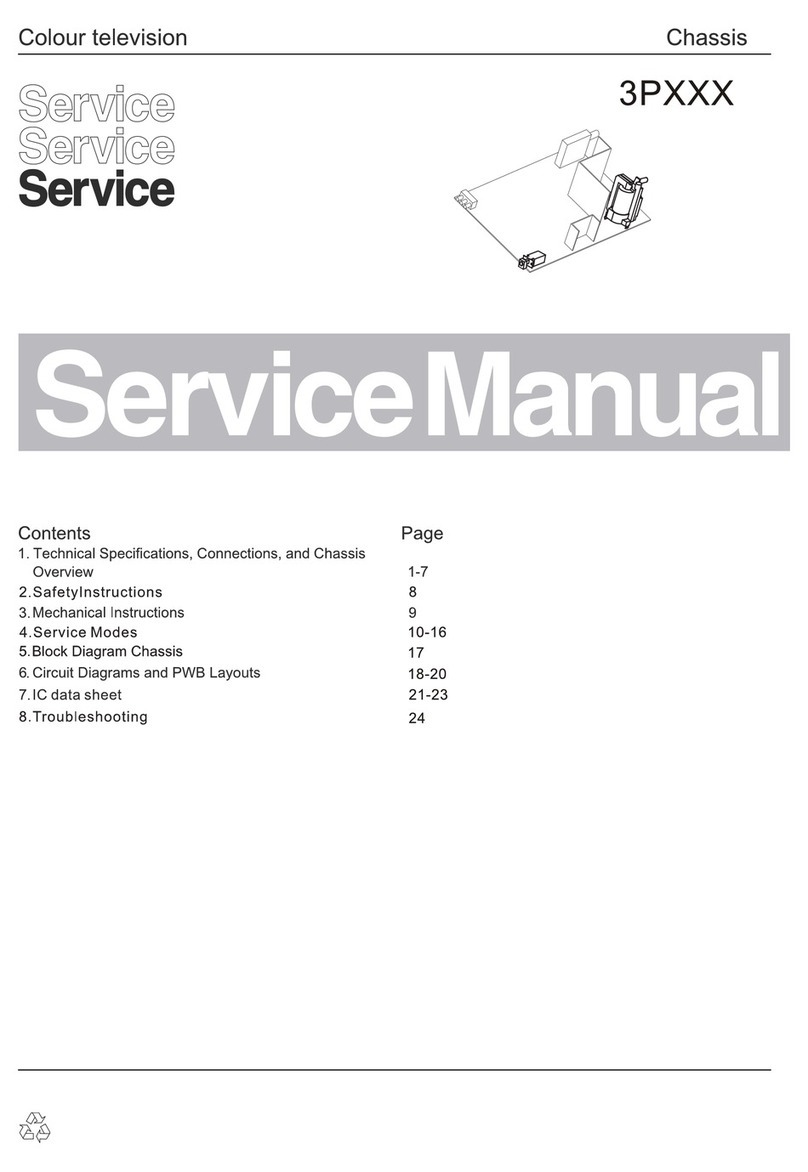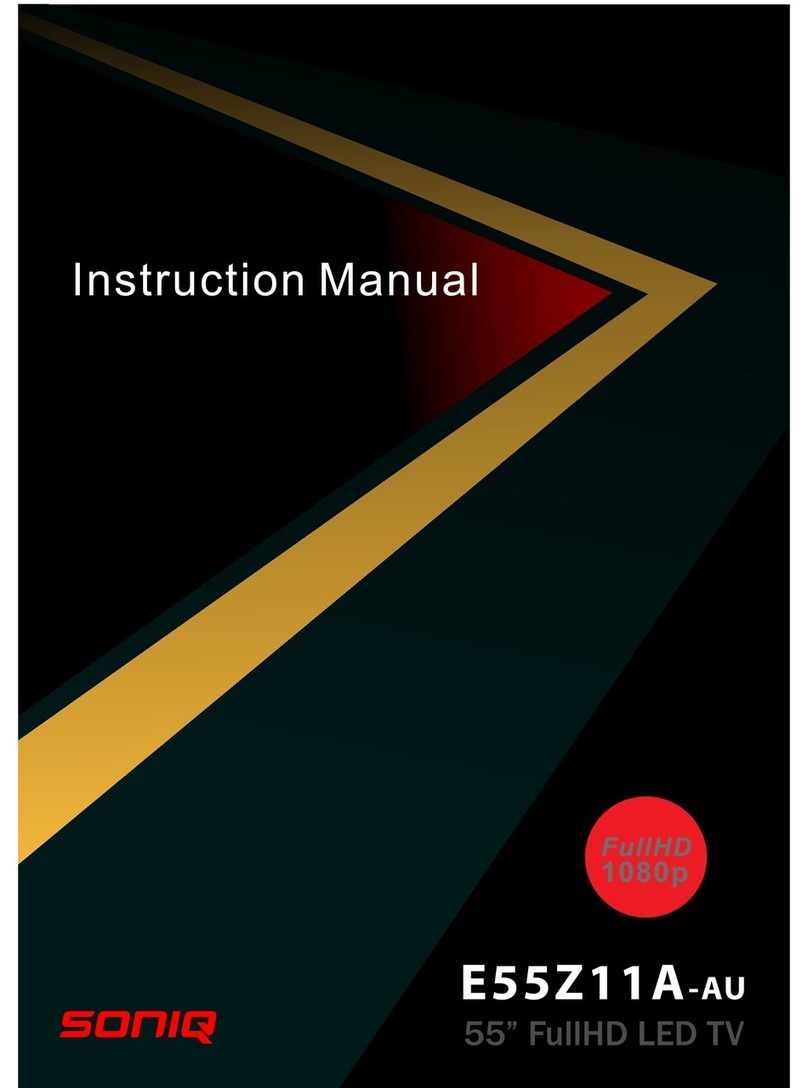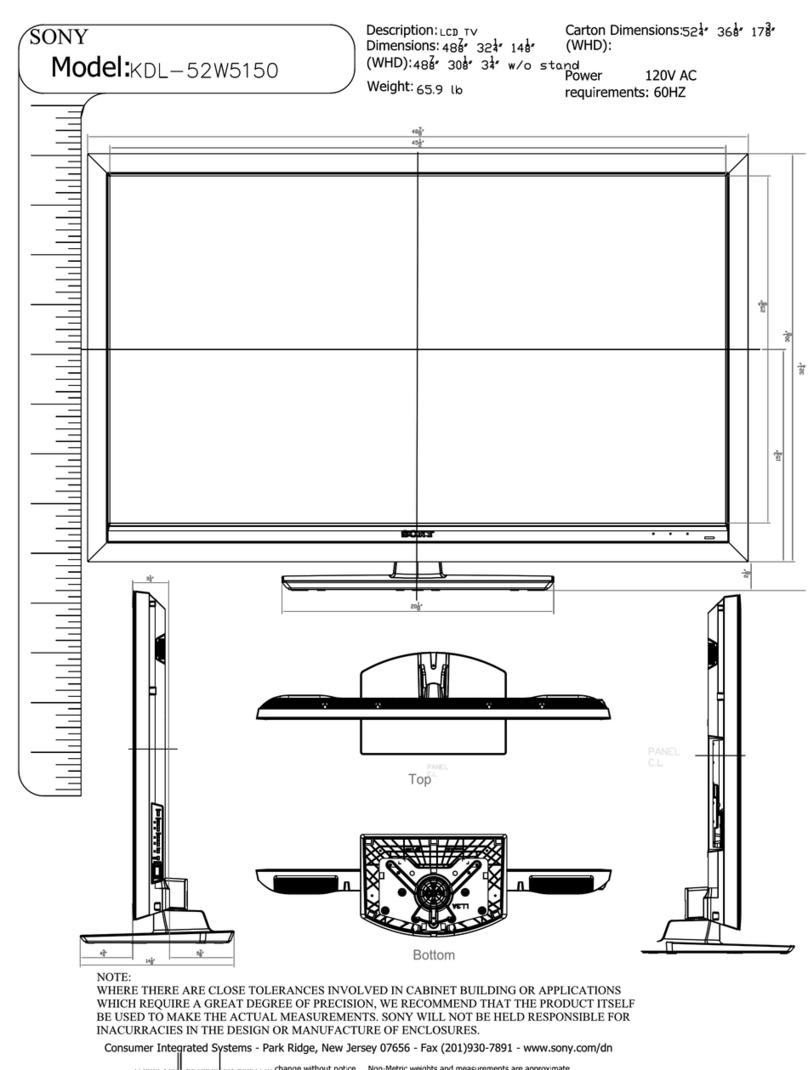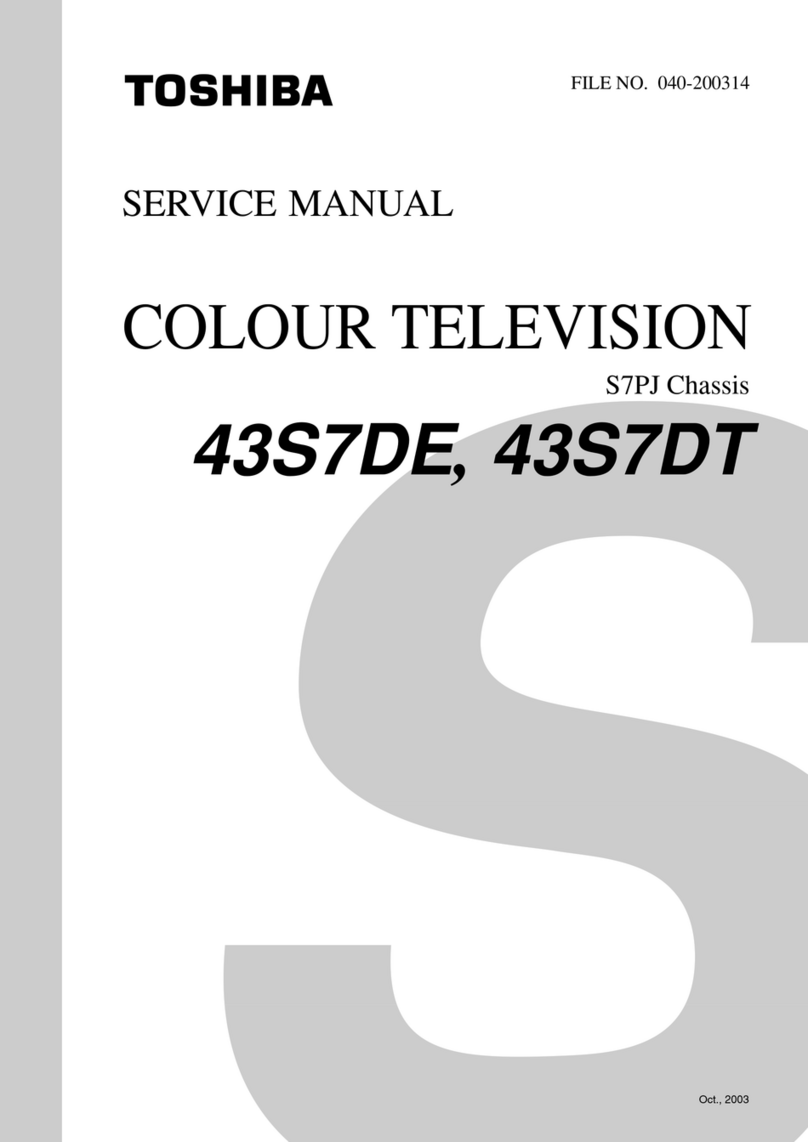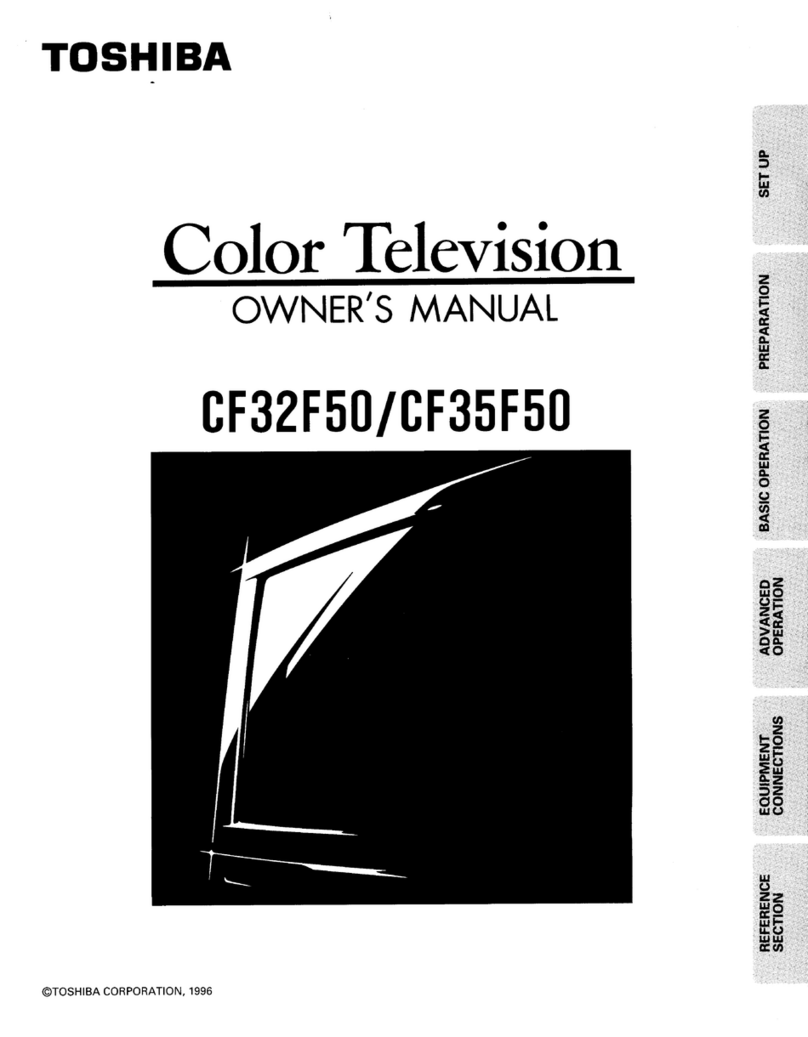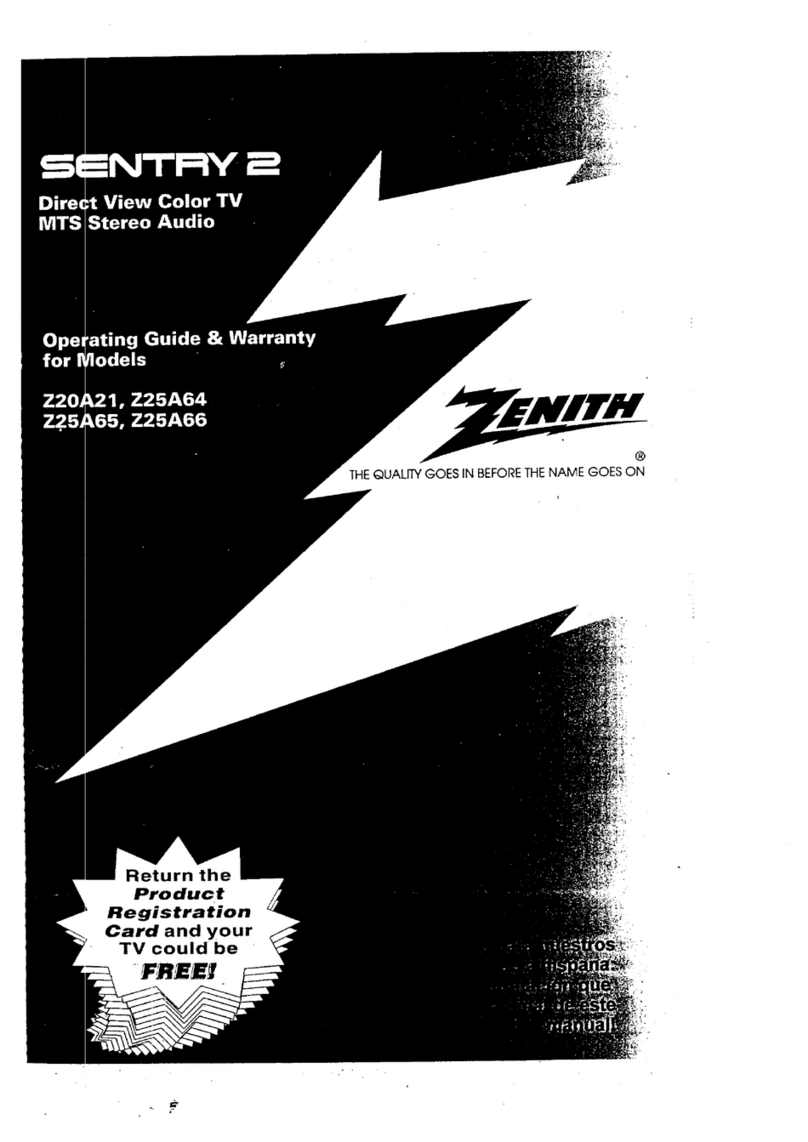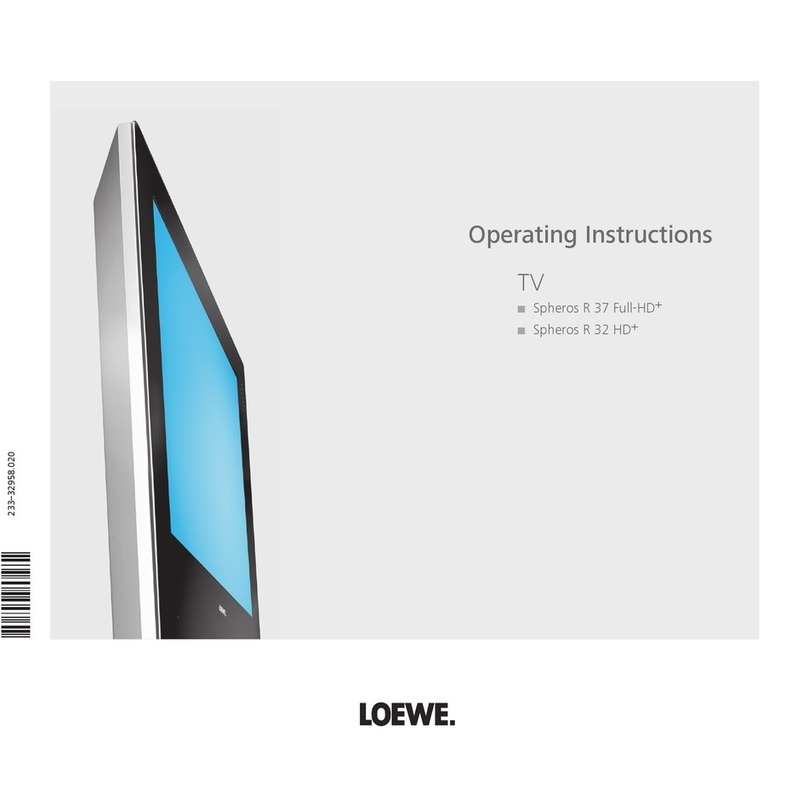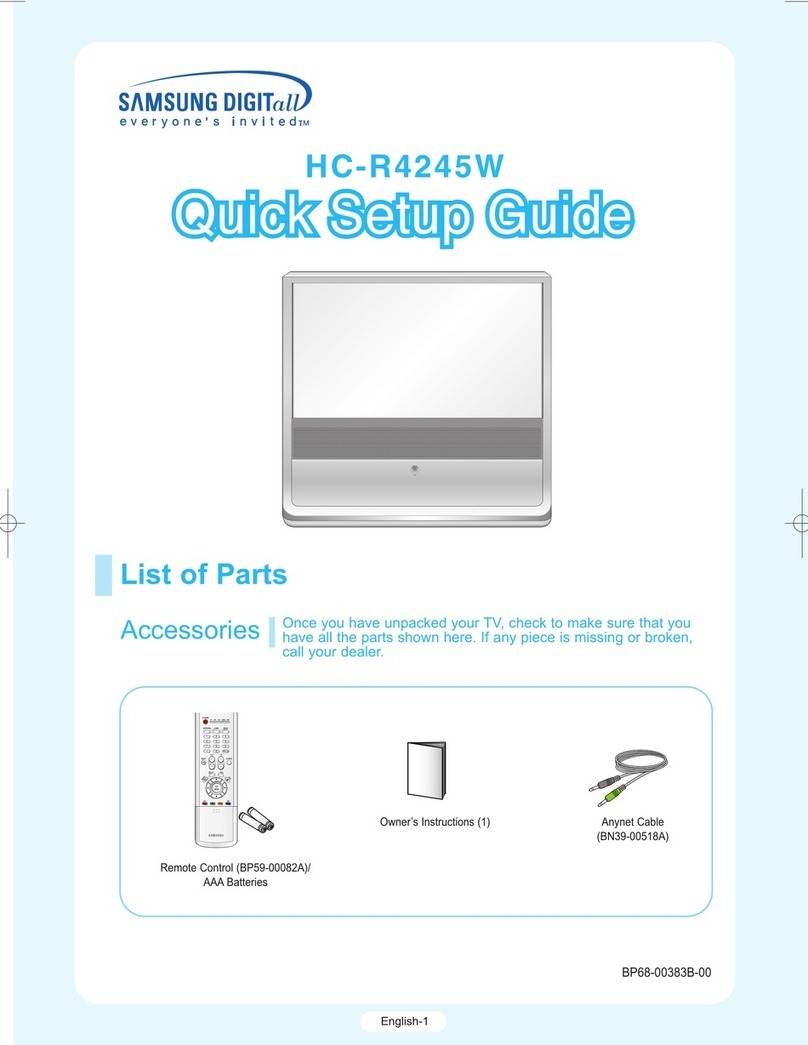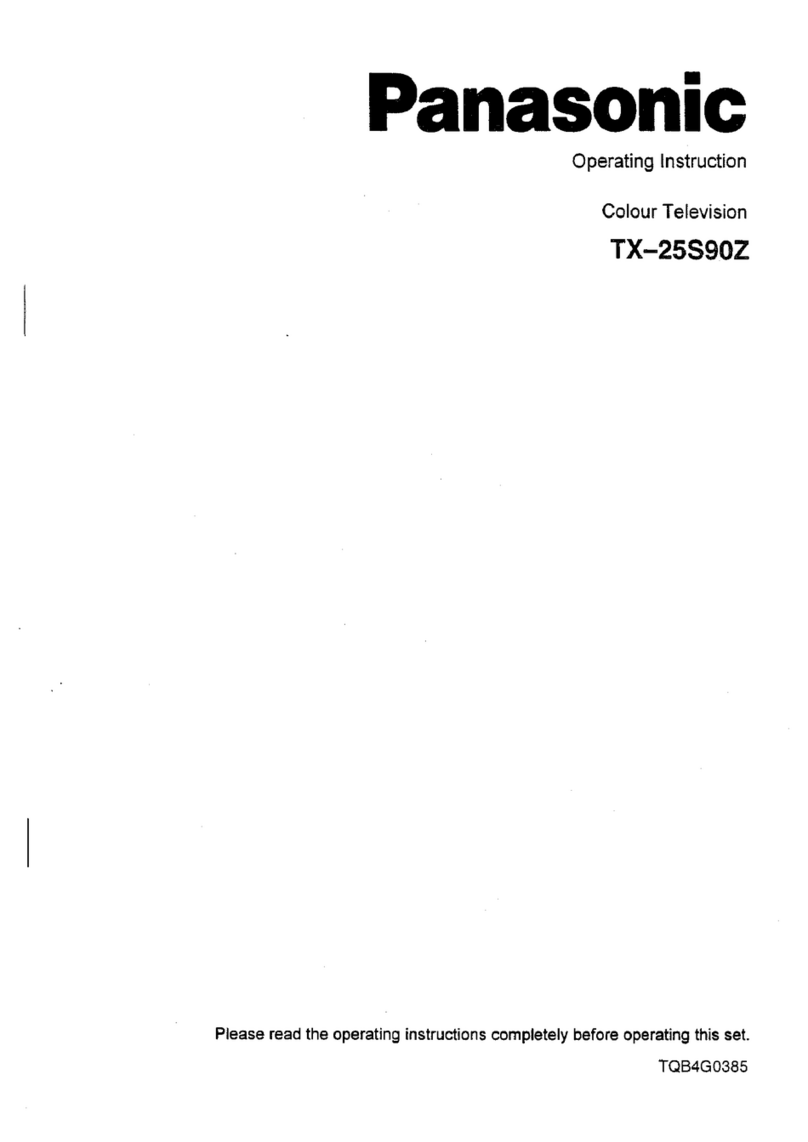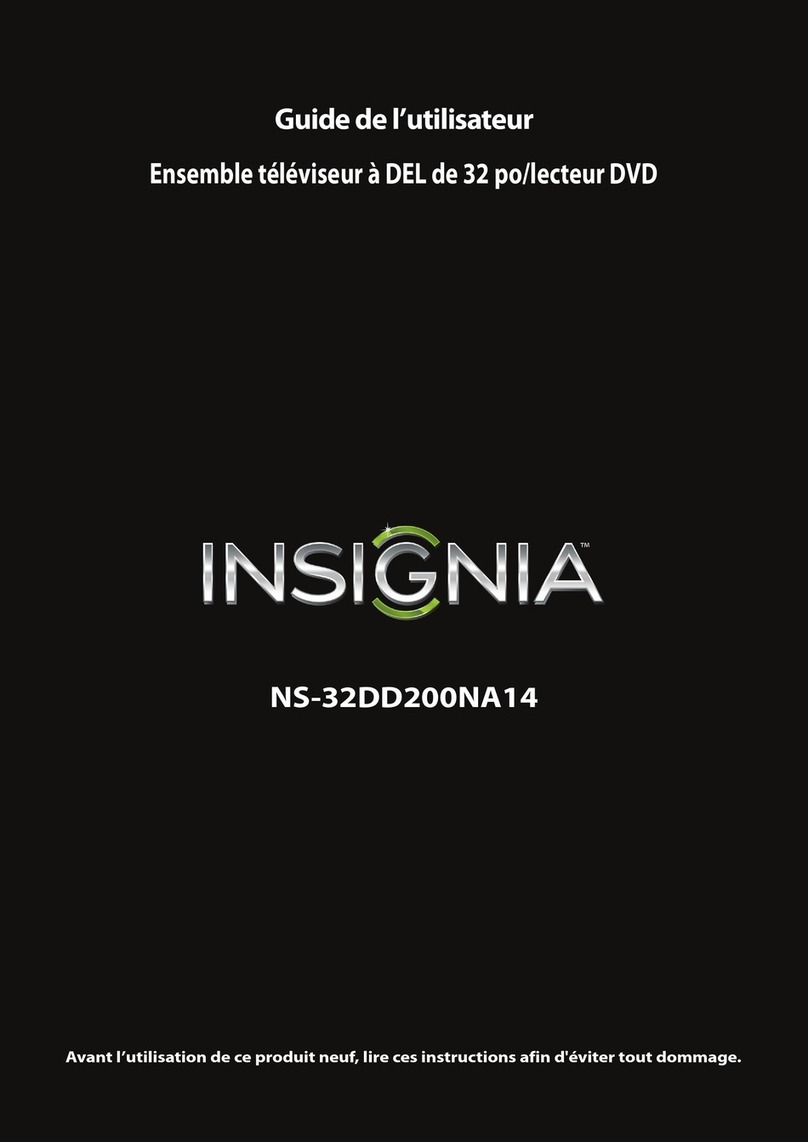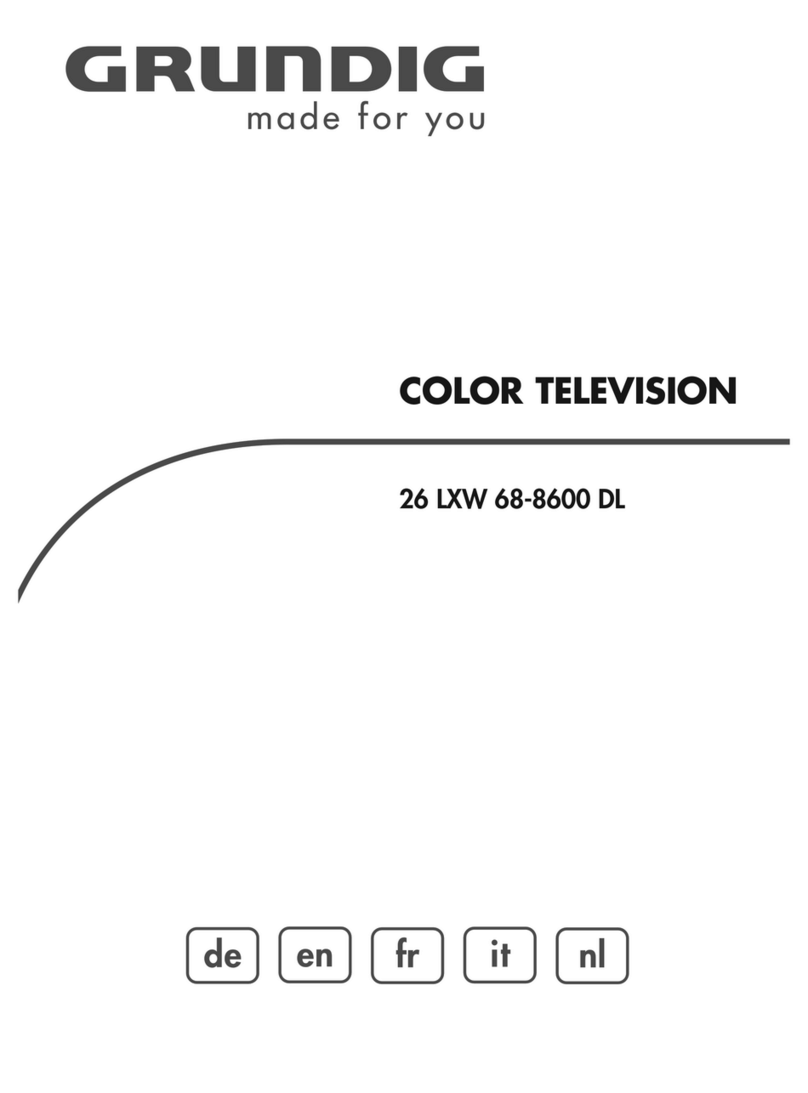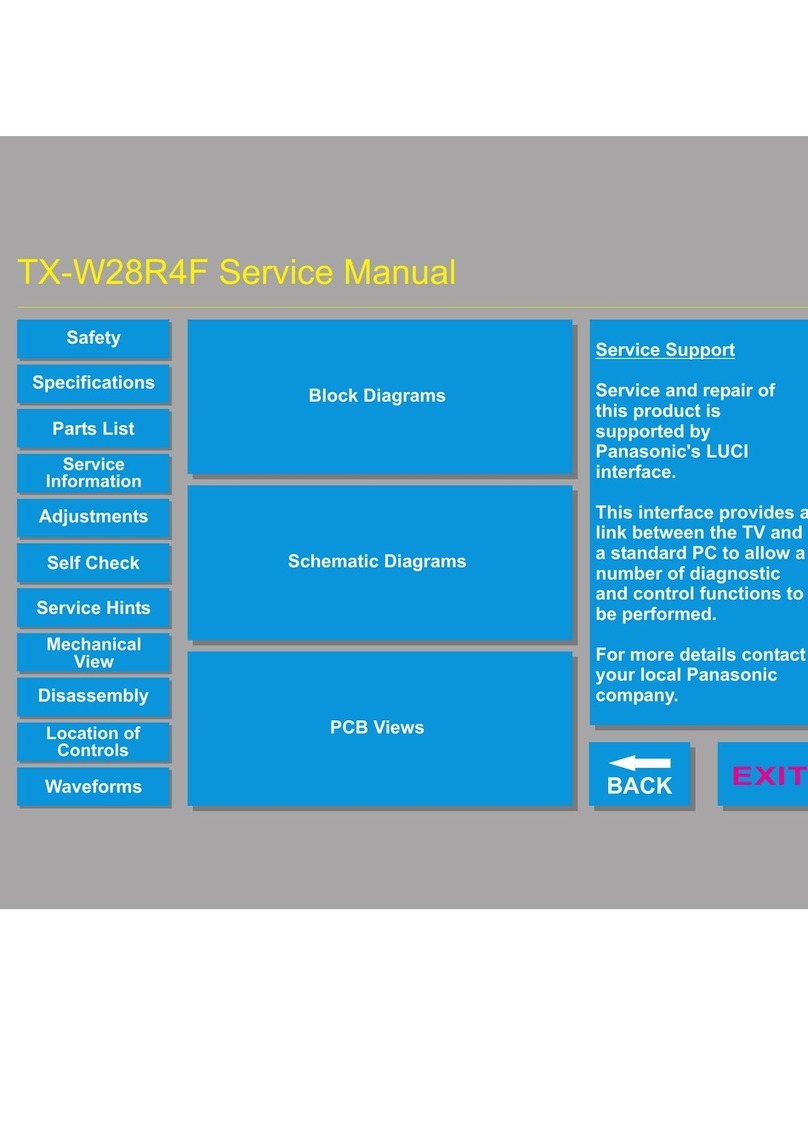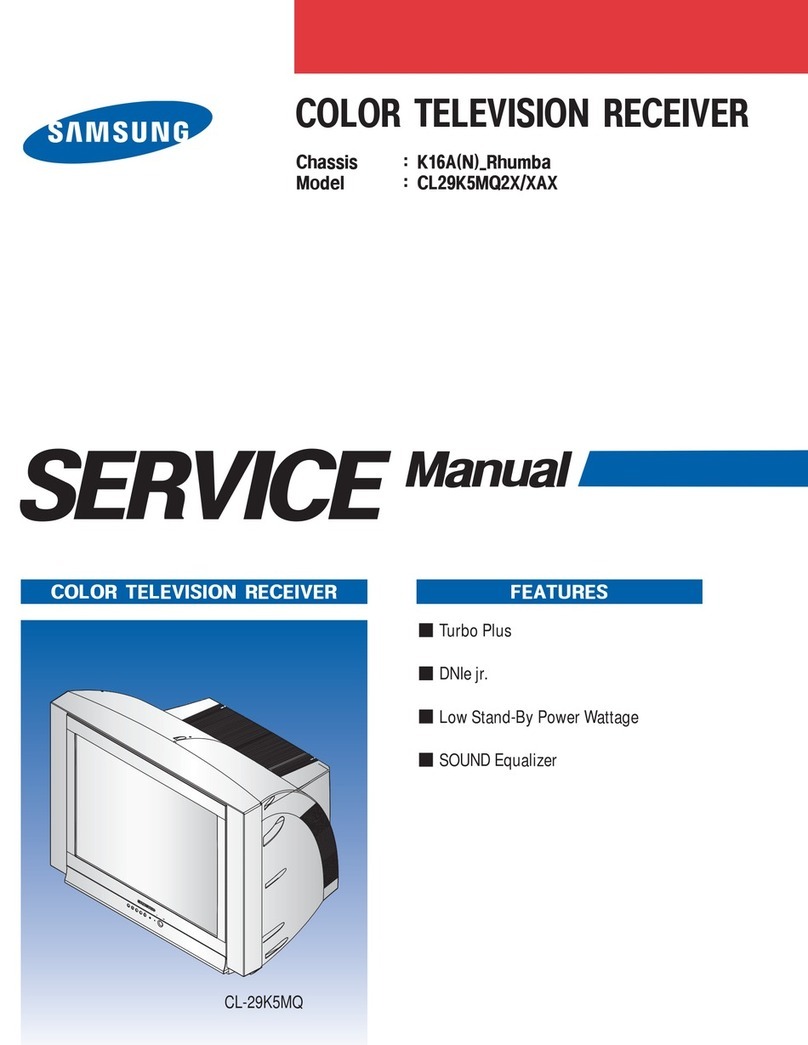ERISSON 21F1 User manual

-1-
PRECAUTIONS DURING SERVICING
1. In addition to safety, other parts and assemblies are
specified for conformance with such regulations as
those applying to spurious radiation. These must also
be replaced only with specified replacements.
Examples: RF converters, tuner units, antenna se-
lection switches, RF cables, noise-blocking capaci-
tors, noise-blocking filters, etc.
2. Use specified internal Wiring. Note especially:
1) Wires covered with PVC tubing
2) Double insulated wires
3) High voltage leads
3. Use specified insulating materials for hazardous live
parts. Note especially:
1) Insulating Tape
2) PVC tubing
3) Spacers (insulating barriers)
4) Insulating sheets for transistors
5) Plastic screws for fixing micro switches
4. When replacing AC primary side components (trans-
formers, power cords, noise blocking capacitors,
etc.), wrap ends of wires securely about the termi-
nals before soldering.
5. Make sure that wires do not contact heat generating
parts (heat sinks, oxide metal film resistors, fusible
resistors, etc.)
6. Check if replaced wires do not contact sharply edged
or pointed parts.
7. Make sure that foreign objects (screws, solder
droplets, etc.) do not remain inside the set.
MAKE YOUR CONTRIBUTION TO PROTECT THE
ENVIRONMENT
Used batteries with the ISO
symbol for recycling as well
as small accumulators (rechargeable
batteries), mini-batteries (cells) and starter batteries
should not be thrown into the garbage can. Please
save them at an appropriate depot.
WARNING:
Before servicing this TV receiver, read the X-RAY
RADIATION PRECAUTION, SAFETY INSTRUCTION and
PRODUCT SAFETY NOTICE.
X-RAY RADIATION PRECAUTION
1. Excessively high can produce potentially hazardous
X-RAY RADIATION. To avoid such hazards, the high
voltage must not exceed the specified limit. The
normal value of the high voltage of this TV receiver
is 26.5 kV at zero beam current (minimum brightness).
The high voltage must not exceed 30 kV under any
circumstances. Each time when a receiver requires
servicing, the high voltage should be checked. The
reading of the high voltage is recommended to be
recorded as a part of the service record, It is important
to use an accurate and reliable high voltage meter.
2. The only source of X-RAY RADIATION in this TV
receiver is the picture tube. For continued X-RAY
RADIATION protection, the replacement tube must be
exactly the same type as specified in the parts list.
3. Some parts in this TV receiver have special safety
related characteristics for X-RADIATION protection.
For continued safety, the parts replacement should
be under taken only after referring the PRODUCT
SAFETY NOTICE.
SAFETY INSTRUCTION
The service should not be attempted by anyone
unfamiliar with the necessary instructions on this TV
receiver. The following are the necessary instructions
to be observed before servicing.
1. An isolation transformer should be connected in the
power line between the receiver and the AC line when
a service is performed on the primary of the converter
transformer of the set.
2. Comply with all caution and safety related provided
on the back of the cabinet, inside the cabinet, on the
chassis or picture tube.
3. To avoid a shock hazard, always discharge the
picture tube's anode to the chassis ground before
removing the anode cap.
4. Completely discharge the high potential voltage of the
picture tube before handling. The picture tube is a
vacuum and if broken, the glass will explode.
5. When replacing a MAIN PCB in the cabinet, always
be certain that all protective are installed properly
such as control knobs, adjustment covers or shields,
barriers, isolation resistor networks etc.
6. When servicing is required, observe the original lead
dressing. Extra precaution should be given to assure
correct lead dressing in the high voltage area.
I. Safety Instructions

-2-
7. Keep wires away from high voltage or high tempera-
ture components.
8. Before returning the set to the customer, always
perform an AC leakage current check on the exposed
metallic parts of the cabinet, such as antennas,
terminals, screwheads, metal overlay, control shafts,
etc., to be sure the set is safe to operate without
danger of electrical shock. Plug the AC line cord
directly to the AC outlet (do not use a line isolation
transformer during this check). Use an AC voltmeter
having 5K ohms volt sensitivity or more in the
following manner.
Connect a 1.5K ohm 10 watt resistor paralleled by
a 0.15µF AC type capacitor, between a good earth
ground (water pipe, conductor etc.,) and the exposed
metallic parts, one at a time.
Measure the AC voltage across the combination of
the 1.5K ohm resistor and 0.15 µF capacitor. Reverse
the AC plug at the AC outlet and repeat the AC voltage
measurements for each exposed metallic part. The
measured voltage must not exceed 0.3V RMS. This
corresponds to 0.5mA AC. Any value exceeding this
limit constitutes a potential shock hazard and must
be corrected immediately.
The resistance measurement should be done between
accessible exposed metal parts and power cord plug
prongs with the power switch "ON". The resistance
should be more than 6M ohms.
PRODUCT SAFETY NOTICE
Many electrical and mechanical parts in this TV
receiver have special safety-related characteristics.
These characteristics are offer passed unnoticed by
visual specification and the protection afforded by them
cannot necessarily be obtained by using replacement
components rates for a higher voltage, wattage, etc.
The replacement parts which have these special safety
characteristics are identified by marks on the
schematic diagram and on the parts list.
Before replacing any of these components, read the
parts list in this manual carefully. The use of substitute
replacement parts which do not have the same safety
characteristics as specified in the parts list may create
shock, fire, X-RAY RADIATION or other hazards.
Good earth
ground such as
the water pipe,
conduit, etc.
Place this
probe on each
exposed
metallic part
AC VOLTMETER
AC Leakage Current Check

-3-
II. Specifications
1. Power supply TV: AC 240V, 50Hz
Remote controller BATTERY: 3V (UM-3X2)
2. TV system RF input: PAL BG/DK,SECAM BG/DK
Video input: PAL/ SECAM/NTSC 3.58/NTSC 4.43
3. Receiving channels VHF-L: E2-S10
VHF-H: E5-S41
UHF: E21-E69
4. Intermediate frequencies picture : 38.9MHz
5. Scanning Horizontal (Hz): 15625/15750
Vertical (Hz) : 50/60
6. Socket Aerial input : 75 ohm unbalanced DIN jack
2AV input/1AV out: RCA sockets
Headphone output: ∅3. 5mm stereo jack
7. Color picture tube: North(2) hemisphere Bv=+0.2G ± 0.2G
8. Speaker : 2" ´ 5" 16 ohm 3W ´2 pcs
9. Operating temperature Fulfil all specifications : 15°C ~ 35°C
Accept picture/sound reproduction: 5°C ~ 45°C
10. Operating relative humidity Fulfil all specifications : 45% ~ 75%
Accept picture/sound reproduction: 15% ~ 90%
11. Electrical & optical specification:
No. Items Instruction Typical Limit Unit
1 Video sensitivity For 30dB S/N VL ≤45 ≤48 dBuV
VH ≤45 ≤48 dBuV
U≤48 ≤51 dBuV
2 FM sound sensitivity For 30dB S/N 30 ≤35 dBuV
3 Synchronizing sensitivity For RF transmission 25 ≤30 dBuV
4 Color sensitivity For RF transmission 32 ≤40 dBuV
5 Teletext sensitivity TV screen refreshes 40 times N/A N/A dBuV
number of mistakes £8
6 Minimum NICAM threshold Without crackline noise N/A N/A dBuV
7 AGC static characteristic Accept. Picture/Sound repr. 103 ≥100 dBuV
8 Selectivity Adjacent sound carrier 40 ≥35
Below adjacent sound carrier 35 ≥30 dB
Adjacent picture carrier 50 ≥40
Up adjacent picture carrier 45 ≥30
9 IF rejection 55 ≥50 dB
10 Image rejection VHF 55 ≥50 dB
UHF 50 ≥45
11 AFT pull-in range M/N N/A N/A MHz
DK/I/BG ±1.5 ≥±1.0
12 Chroma sync pull-in range ±500 ≥±200Hz
13 Color killer function -25 ≤-16 dB
14 DC restoration 3 ≤10 %
15 Resolution Horizontal PAL/SECAM 320 ≥300
NTSC 270 ≥250
Vertical PAL/SECAM 410 ≥400 lines
NTSC 320 ≥300
16 Overscan Cross hatch signal 93 90~96 %
17 Linearity Horizontal 7 ≤10 %
Vertical 6 ≤8%
18 Pattern distortion 1.5 ≤3%
19 Picture position In all direction ±3 ≤±6mm

-4-
Test Condition
1 Picture Modulation 87.5%
2 Sound Modulation 27KHz Dev. For DK/I/BG
15KHz Dev. For M/N
3 Picture to Sound Ration 10dB
4 Sound Artificial Load Resistor 8 ohm
5 Video signal White and black
(three white & two black)
6 Audio signal 1KHz sine wave 0.5Wrms Convergence error test point on screen
7 Conditions of the TV setting:
A. Switch TV on and let it warm up for more than 30 minutes.
B. Connect RMS volt meter to speaker terminals and adjust theTV volume to get 500mW RMS power at each terminal.
C. Place the MINOLTA CA-100 test probe to white part of the screen,adjust the contrast until a reading of 80cd/m2 is obtained.
D. Place the MINOLTA CA-100 test probe to black part of the screen,adjust the brightness until a reading of 2cd/m2 is obtained.
E. Repeat step C & D until the exact luminance values is obtained or the nearest possible values you can get.then record the
luminance values & R.G.B gun voltage values at the same time. and take the largest values for measurement referenct.
F. Input standard color bar(100/0/75/0),then adjust the colour.until the waveforms at the blue gun of same level is obtained.
W
H
1/9H
1/9W
+P8 P5+
+P4 P2+
+P1
+P0
+P7 +P3 P6+
No. Items Instruction Typical Limit Unit
20 Raster rotation In all direction 4 ≤6mm
21 Convergence error 0.4 ≤0.6 %
22 White balance (8700°K) X 0.288 0.288±0.015
Y 0.298 0.298±0.015 /
23 Maximum full white At picture tube center 110 ≥100 cd/m2
24 H sync pull-in range ±500 ≥±200Hz
25 V sync pull-in range 7 ≥6Hz
26 Anode voltage 25 ≤27.5 KV
27 Audio frequence response ±3dB ref. to 1KHz 0.2~8 0.2~8 KHz
28 Audio output power 1KHz 10% THD 2×1.6 ≥2×1.6 W
29 Max audio output power 1KHz THD ≥20% 2×2≥2×2W
50 KHz DEV.(BG/I/DK)
25 KHz DEV.(M/N)
30 THD Po=0.5W 1KHz 1 ≤3%
31 Signal to buzz ratio 42 ≥40 dB
32 Minimum volume hum 6 ≤10 mVrms
33 Maximum woofer output power N/A N/A W
34 Woofer audio freqency response ±3dB ref. to 80Hz AV mode N/A N/A Hz
35 Bass control range 100Hz ref. to 1KHz AV mode N/A N/A dB
36 Treble control range 10KHz ref. to 1KHz AV mode N/A N/A dB
37 Balance Center N/A N/A dB
Max. N/A N/A
Min. N/A N/A
38 Volume control curve N/A /
39 Video input level 1.0 1±0.2 Vpp
40 Audio input level 0.5 0.5±0.3 Vrms
41 Video output level 1.0 1±0.2 Vpp
42 Audio output level 0.5 0.5±0.2 Vrms
43 Power consumpution Operating 80 ≤95
Stand by 10 ≤15 W
44 IR receiving distance ±30° 6 ≥5m
45 X-ray radiation ≤0.1 ≤0.5 mR/h
46 Dielectric strength AC 3KVrms 2 sec. 3 ≤5 mArms

- 5 -
III. Block Diagram

- 6 -
IV. Wiring Diagram
(Onlyfor21A9BN34)

-7-
V. Disassembly
In case of trouble, etc., necessitating dismantling, please dismantle in the order shown in the illustrations. Reassemble
in the reverse order.
i. Removal of the Back Cover
1 Remove the screws as shown.
2 Pull out the back cover slightly.
3 Pull up the connector of the two lead wires (red black) connecting to the speakers on
the cover from the MAIN PCB.
ii. Removal of the Main PCB
1 Remove the two screws.
2 Slide out the TV chassis slightly; pull up the connector of AC cord from PCB; Pull up the CRT PCB from CRT.
3 Remove the anode cap from the picture tube. To avoid a shock hazard, be sure to discharge the picture tube's
anode to the chassis ground before removal.
4 Take out the TV chassis.
VI. Alignment Instructions
i. Before Adjustment and Maintenance
A. Don't short any two soldering points or connect any component while TV set is power on.
B. Pull out power plug before maintenance.
C. In order to ensure safety all components replaced should be identical with originals.
(For further details, refer to the component name and component No. in PARTS LIST.)
D. Must warm up for 30 minutes or more and degauss CRT thoroughly with demagnetiser before alignment.
ii. Equipments for adjustment
A. Pattern generator B. Digital voltmeter
C. High voltage meter D. Sine wave signal generator
E. Demagnetiser F. Personal computer (486)
G. DC regulated power supply H. Oscilloscope
I. CRT colour analyzer (MINOLTA CA-100)
iii. Input signals
A. PHILIPS pattern B. Color bar
C. Cross hatch D. Grey scale bar
E. Monoscope pattern F. Moving picture with sound

- 8 -
iv. Adjustment Location
A. Option Code
The option code listed below is for selection of different TV systems, features and functions, the code is preset in
factory, in case of changing the EEPROM, the option code will not be the same as before. In this case, it is necessary
to adjust the option code again. How to set the option code by hand is described in "method to enter into SERVICE
MENU and ADJUST MENU". Please refer to "IV. Electrical Adjustment".
The option setup is as follows: OPTION MENU
Every digit represents the lower 3 bits of a nibble of 4 bytes in EEPROM, and each of the bits
stands for an option function, the option bits listed below:
0123456789
0123456789
BIT7 BIT6 BIT5 BIT4 BIT3 BIT2 BIT1 BIT0
BYTE1 NU OQSS OSVD OAV2 NU OCHIL OWOO OUHF
BYTE2 NU OSYS1 OSYS2 OSYS3 NU OTUN1 OTUN2 OTUN3
BYTE3 NU OBL OSND1 OSNDB NU OSNDI OSNDD OSNDM
BYTE4 NU ORUSS OBB OTVO NU OCHIT OCHIS OENG
BYTE5 NU OMSIF OBGSIF OISIF NU ODKSIF OCHAN2 OCHAN1
VII. EEPROM (IC602) setting
Model Option code
21W3BN37/21A9BN34 5463122106
DIGIT 1:
1 OQSS 0 = QSS OFF
1 = QSS ON
2/3 MODE OSVD OAV2
TV/AV 0 0
TV/AV1/AV2 0 1
TV/AV1/AV2/SVD 1 1

- 9 -
Digit 2:
4 OCHIL 0 = CHILD LOCK NOT AVAILABLE
1 = CHILD LOCK AVAILABLE
5 OSIFE 0 = WOOFER NOT AVAILABLE
1 = WOOFER AVAILABLE
6 OUHF 0 = ALL BAND (VL, VH, UHF)
1 = UHF ONLY
Digit 3:
7 OSYS1 0 = SINGLE COLOR SYSTEM (PAL) AVAILABLE
1 = MULTI COLOR SYSTEM (AUTO/PAL) AVAILABLE
8 OSYS2 0 = MULTI SYSTEM SECAM NOT AVAILABLE (TV & AV)
1 = MULTI SYSTEM SECAM AVAILABLE (TV & AV)
9 OSYS3 0 = MULTI SYSTEM NTSC NOT AVAILABLE (TV)
1 = MULTI SYSTEM NTSC AVAILABLE (TV)
Digit 4: TUNERIF SETUP: OTUN1 OTUN2 OTUN3
34.47 MHz 0 0 0
36.875 MHz 0 0 1
38 MHz 0 1 0
38.9 MHz 0 1 1
39.5 MHz 1 0 0
45.75 MHz 1 0 1
Digit 5:
13 OBL 0 = BILINGUAL (MAIN/SUB) NOT AVAILABLE
1 = BILINGUAL (MAIN/SUB) AVAILABLE
14 OSND1 0 = MULTI SIF SYSTEM AVAILABLE
1 = SINGLE SIF SYSTEM AVAILABLE
-- THIS OPTION IS NOT COUNT BILINGUAL
15 OSNDB 0 = SIF [BG] NOT AVAILABLE
1 = SIF [BG] AVAILABLE
Digit 6:
16 OSNDI 0 = SIF [I] NOT AVAILABLE
1 = SIF [I] AVAILABLE
17 OSNDD 0 = SIF [DK] NOT AVAILABLE
1 = SIF [DK] AVAILABLE
18 OSNDM 0 = SIF [M] NOT AVAILABLE
1 = SIF [M] AVAILABLE
Digit 7:
19 ORUSS 0 = RUSSIAN OSD NOT AVAILABLE
1 = RUSSIAN OSD AVAILABLE
20 OBB 0 = BLUE BACK NOT AVAILABLE
1 = BLUE BACK AVAILABLE
21 OTVO 0 = SCART MONITOR OUTPUT
1 = SCART TV OUTPUT
Digit 8:
22 OCHIT 0 = TRADITIONAL CHINESE (HK) OSD NOT AVAILABLE
1 = TRADITIONAL CHINESE (HK) OSD AVAILABLE
23 OCHIS 0 = SIMPLE CHINESE (CHINA) OSD NOT AVAILABLE
1 = SIMPLE CHINESE (CHINA) OSD AVAILABLE
24 OENG 0 = ENGLISH OSD NOT AVAILABLE
1 = ENGLISH OSD AVAILABLE
Digit 9:
25 OMSIF 0 = M SIF INTERNAL
1 = M SIF EXTERNAL
26 OBGSIF 0 = BG SIF INTERNAL
1 = BG SIF EXTERNAL
27 OISIF 0 = I SIF INTERNAL
1 = I SIF EXTERNAL

- 10 -
Digit 10:
28 ODKSIF 0 = DK SIF INTERNAL
1 = DK SIF EXTERNAL
29/30 CHANNEL NUMBER 0CHAN2 0CHAN1
100 0 0
200 0 1
254 1 0
NU: NOT USED RES: RESERVED
ii. Data Setting
The data setting item B~D is the initialization data preset in the EEPROM before adjustments described in the
following paragraph, in case of changing the EEPROM, please set the data to initialization data listed below,
before adjustment, how to set the data by hand is described in “method to enter into SERVICE MENU and
ADJUST MENU”.
Parameter Value(DEC) Remark Parameter Value(DEC) Remark
SUB BRI 63 HOR.POS60 13
CUTOFF R 63 VER.POS60 0
CUTOFF G 63 VER.H60 81
CUTOFF B 63 VER.LIN60 40 Remark1
DRIVE R 63 VER.S C60 20 Remark1
DRIVE B 63 SUBTINT 16
AFT ADJ 55 AV S TINT 16
RFAGCDP 45 C-Y 1 Remark2
SECAM BL 0 HOR.VCO 52
RGB LIMIT 0 VIF.VCO 26
HOR.POS 13 ISUD5 1 Remark3
VER.POS 0 ISUD4 1
VER.HEI 84 ISUD3 1
VER.LIN 40 Remark1 CONTR 32 0
VER.S CUR 20 Remark1 RI CUTOF 1
Remark1: For different CRT, the following data are recommended to changed for better performance
before alignment.
These data setting are listed as following:
CRT CRT Type No. Value
VER.LIN VER.SCUR VER.LIN60 VER.SC60
21” 102-321001-03 54SX503Y22-DC01 N2 38 20 36 20
IRICO
Remark2: C-Y: 0 For MFxx models (use NN5198K).
C-Y: 1 For other models (use NN5199K/NN5099K).
Remark3: ISUD5 must set to “0” after. Please checked ISUD5 after Read 5198.
iii. Intelligent picture control (I.P.C) DATA SETTING
Control Value
Natural Sharp Cinema Personal
Brightness 16 24 12 16
Contrast 24 32 16 24
Colour 16 20 16 16
Sharpness 16 24 16 16
Tint 16 16 16 16

-11-
iv. AFT Data Setting
Remark: This table of AFT DATA setting is only for:
SAMSUNG tuner: TECC0949VG28B and WITTIS tuner: UVS1051-CW /UVS1051-NEW.
A. Chassis adjustment
i. +B voltage alignment
a. Preparation Procedure.
1. Receive standard colour bar signal.
2. Press key "I.P.C." to Select “Natural” Status.
3. Connect digital voltmeter between of C416 and GND.
4. +B voltage
NOTE: Please refer to the CRT conversion table for other CRT.
b. Adjustment Step
Adjust VR901 to make the read-out on the Voltmeter to be +B±0.3V.
ii. Method to enter into SERVICE MENU and ADJUST MENU
a. Turn on the Main Power Switch, then Press Volume Buttons Both "+" and "-" Simultaneously for over 5S, the
"KWUAA SERVICE" will be displayed on the screen.
b. The “KWUAA SERVICE” menu is indicated with each item on the screen. The item can be selected by pressing
channel “ ” and “ ” keys.
c. Selecting “Read 5198”, press “MENU/OK” key (or press “OK” key on the remote handset) to read IC
NN5199K/NN5198K DATA in order to operate the TV set. On-screen display will be shown as follows:
Press “MENU/OK” key (or press “OK” key on the remote handset) to confirm Read 5198.
Press “M” key on the remote handset to exit.
Note: 1.Many standard data are already preset in the EEPROM inside IC NN5198K of 5099K by the IC
manufacturer. During manufacturing the TV set, it is necessary to read those data that stored in
EEPROM of IC NN5099K and memorize it in external EEPROM. By doing so, some alignment can
be omitted, or the data memorized in the external EEPROM can be changed according to the situation.
Please note that according to the specification the operation of “reading” data from the EEPROM
inside NN5198K only can be done 1000 times, when changing IC201 (NN5198K or NN5099K)/ IC602
(EEPROM) or before adjusting, it is necessary to read NN5198K or 5099K data one time.
2.CNT: ‘x’ means number of times that the data stored in the EEPROM of NN5198K or NN5099K
has been read. For example, CNT: ‘9’ , it means the data stored in the EEPROM of NN5198K or
NN5099K has been read 9 times.
KWUAA SERVICE
Adjustment
Option xxxxxxxx
Confirm Read ??? X
Other Adj.
VIII. Electrical adjustment
KWUAA SERVICE
Adjustment
Option xxxxxxxx
Read 5198 CNT: X
Other Adj.
Model CRT CRT Type No. +B
21”BN37/BN34 102-321001-03 54SX503Y22-DC01 N2 +106V
Description Value
VHFL VHFH UHF
Low 120 56 35
Middle 97 40 31
High 131 76 90

-12-
d. Selecting “Option”, press “OK” key then input the option code by number keys on the remote handset according to the
A. Option code. After changing “OPTION”, the TV set must be set to standby and power on again, then enter
into “SERVICE MENU”.
e. Select “Adjustment”, press “OK” key on the remote handset. The “ADJUST MENU” is indicated with each parameter
on the screen. Pressing channel “ ” and “ ” keys can select the responding parameter. The parameter value
can be changed by pressing volume “+” and “-” keys. Press “OK” key to exit.
f. Select “Other Adj.” press “MENU/OK” (or press “OK” key on the remote handset), On-screen display will be
shown as follows:
1. Production
Normal “Production” is set to “off”, if “Production” is set to “on”, the TV set can’t standby and appeared BLUE
BACK when no RF signal inputting, the top on the On-screen will display a “P” character when changing
channel, this feature is for production use only. press volume “+” and “-” keys to set to “off” or “on”, press
“MENU” to EXIT.
2. AFT-Step
Selecting “AFT-Step” to set AFT DATA, press “OK” key to enter, On-screen display will be showed as follows:
Use channel “ ” and “ ” keys to select the parameter, the parameter value can be changed by pressing
volume “+” and “-” keys. See “D. AFT data setting”. Press “M” key to exit.
3. IPC
Selecting “IPC” to set picture mode data, press “OK” key to enter, the picture mode data is indicated with
each parameter on the screen. Press “I.P.C.” key to select picture mode, select the parameter and change
the parameter value, when this picture mode data is OK, press “OK” key to store, the parameter value below
will display “Stored”, when all picture mode data is being stored, press “MENU” key to exit.
iii. Adjustment of AFC
a. Preparation procedure
1. Turn on the main power switch.
2. Set digital voltmeter at DC, then connect its probes across of R603 and GND.
3. Add 100dBµV IF signal between IF Pin and GND of the TUNER on main PC board (see FIG.1).
b. Adjustment Step
Adjust the “AFT ADJ” DATA until the meter indicates 2.4±0.1V.
KWUAA AFT-STEP 09-08
Band VHFL
Low 120
Middle 97
High 131
Sine Wave
Signal
DIGITALVOLTMETER
R603
(FIG.1)
KWUAA OTHER
Production off
AFT-Step
IPC

-13-
c. AFC Check.
After adjustment ,it is necessary to confirm the DC voltage across R603 when changing the RF output frequency of
pattern generator (PM5518) by ±0.1MHz, the DC voltage should be as following:
Remark: IF=38.9MHz .
If Q.C. checked AFC voltage on the production, the AFC voltage should be 2.4±0.5V. If the
result is not satisfactory, repeat adjustment step ‘b. Adjustment step’ until correct voltage
is obtained.
iv. Adjustment for H position and V position, V-height and V linearity.
a. Receive pattern signal (PAL).
b. Enter ADJUST MENU.
1. Adjust value of HOR.POS to get a good H position picture.
2. Adjust value of VER.HEI to get a normal picture.
3. Adjust value of VER.POS to get a good V position picture.
4. Normal VER.LIN and VER.S CUR isn’t need adjust. If V linearity is not good, please adjust value of VER.LIN and
VER.SCUR to get a good V linearity picture.
c. Receive pattern signal (NTSC).
d. Enter ADJUST MENU
1. Adjust value of HOR.POS60 to get a good H position picture.
2. Adjust value of VER.H60 to get a normal picture.
3. Adjust value of VER.POS60 to get a good V position picture.
4. Normal VER.LIN60 and VER.SC60 isn’t need adjust. If V linearity is not good, please adjust value of VER.LIN60 and
VER.SC60 to get a good V linearity picture.
v. Adjustment for TV TINT (TV picture) and AV TINT (AV picture)
(step a~d is only for MFxx models)
a. Receive a NTSC color bar pattern signal from RF.
b. Press key “I.P.C.” to set contrast, Brightness, Color and Tint at normal position.
c. Put the Probe of Oscilloscope to “B-out” Terminal of IC201 PIN 12.
d. Enter ADJUST MEMU
Adjust Value of SUBTINT and Notice the Waveform Change Until the Waveform is shown as below:
e. Receive a NTSC Color bar Signal from AV.
f. Enter ADJUST MENU
Adjust the Value of AV S TINT until the Waveform of Oscilloscope is shown as above.
vi. Adjustment for SECAM BL (only for MFxx or use NN5198K models)
a. Receive a SECAM dot pattern signal from RF.
b. Press key “I.P.C” to select “NATURAL” status.
c. Put the Probe of Oscilloscope to “B-out” Terminal of IC201 Pin12 and GND. (Probe: 10:1,
Oscilloscope VOLTS / DIV: 20mv / DIV.
d. Enter ADJUST MENU.
Adjust Value of SECAM BL until Vis smallest. v
RF FREQUENCY DC VOLTMETER INDICATION
IF + 0.1MHz 1.2 ± 0.5V
IF - 0.1MHz 3.3 ± 0.5V

-14-
vii. Adjustment for RF AGC
a. Receive RF signal (62±3dBµV).
b. Enter into ADJUST MENU.
c. Pressing channel “ ” and “ ” keys on the remote handset, and on-screen display will be shown as follows:
d. Press Volume "+" or "-" on the remote handset to change the value of RFAGCDP until snow noise on the screen just
disappears.
e. Press “M” KEY to exit from ADJUST MENU.
viii.Adjustment for Sub-brightness
a. Receive MONOSCOPE Pattern.
b. Press key “I.P.C” on the remote handset to set Brightness and Contrast at Natural State.
c. Enter into ADJUST MENU.
d. Pressing channel “ ” and “ ” on the remote handset, the display on screen will be:
e. Press Volume “+” or “-” on the remote handset to change the value of SUB BRI until eight and half of portions
indicated in FIG.2 is just visible. Press “M” key to exit ADJUST MENU.
ix. Adjustment for FOCUS (See FIG.3)
a. Press key "I.P.C." on the remote handset to set
brightness and contrast both at normal position.
b. Adjust knob "FOCUS" on FBT to make the picture
on the screen to be the most distinct.
x. Adjustment with computer
INTRODUCTION
"UBM" is an adjustment program for colour TV set which use NN5199K/NN5198K as the chroma I.C..
This program controls the TV set though IIC interface and provides Auto Adjustment of the White-Balance by using the
Colour Analyzer (MINOLTA CA-100.)
SET UP
1. The computer must be installed with the software program named UBM.
2. Power on the TV set and your computer.
3. Connect the computer and connect the adjustment cable from computer to the TV chassis at vocation CN601 as
following:
4. C:\ cd UBM ENTER
5. C:\ cd UBM > UBM ENTER
CHOICE CPU PROGRAM
Use keys “ ” in the computer to select the software program named UBM, then press
‘ENTER’ key in the computer, the screen will display:
SUB BRI XX
RFAGCDP XX
( FIG.3 )
( FIG. 2 )
COM1 CN601
TV set chassis

-15-
This is the main menu for adjustment and the different data can be changed and viewed.
It consists of following functions.
A. WHITE BALANCE ADJUSTMENT D. PC SELF TEST
B. SETUP E. WHITE BALANCE PARAMETER SETUP
C. READ EEPROM F. EXIT
P1 P2
Function A: WB AUTO ADJUST
Before enter to WB AUTO ADJUST, make sure the WB setup (Function E) is fulfil your adjustment requirement.
Procedure:
1. Check WB setup and to define standard and tolerance.
2. Connect the colour Analyzer — Minolta CA-100 to the computer (COM 1).
3. Turn on the TV set and receive the White-Grey signal.
4. Connect the adjustment cable to the TV set IIC interface
5. Press Space Bar, the computer will DISPLAY "Please adjust screen Voltage, space Bar to continue". Now change
to TV service mode and adjust the
screen voltage until a dim line on the screen, then back to normal mode.
6. Put the colour probe 1 to the low luminance side and colour probe
2 to the high luminance side of the screen. (It is better to place
near the center of the screen.)
7. Press Space Bar to start WB adjustment.
ZHONG SHAN KAWA ELECTRONIC RESEARCH & DEVELOPMENT CENTER
AUTO ADJUSTMENT FOR COLOUR TV SET (VERSION V1.00 FOR)
CPU Program Name:
UBM UBMT
Your Computer is: PC/AT 80386 33MHz
If Information of Your Computer not Right, Please Run SELF TEST.
Use , Key to Select Options, Enter to Confirm or Esc to Quit.
(A) WB AUTO ADJUST
(B) SETUP EEPROM
(C) READ EEPROM
(D) PC SELF TEST
(E) WB PARMS SETUP
(F) EXIT TO DOS
Your Computer is: PC/AT 80386 33MHz
If Information of Your Computer not Right, Please Run SELF TEST.
Use , Key to Select Options, Enter to Confirm or Esc to Quit.
ZHONG SHAN KAWA ELECTRONIC RESEARCH & DEVELOPMENT CENTER
AUTO ADJUSTMENT FOR COLOUR TV SET (VERSION V1.00 FOR)

-16-
If the WB adjustment is success, the computer will display "Finished to adjust white Balance" and show all value
and adjustment time used, then the user must put off the adjustment cable from the TV IIC interface now. Then
repeat from the step 3 for another TV set adjustment.
If the adjustment cannot be finished within your preset time limit, the computer will display "Sorry, adjustment
stopped!" and the adjustment is failed. It is better to call technician to check the TV hardware if the adjustment
failed several times.
Function B: Setup EEPROM
The function: "SETUP EEPROM" is used for writing a date file to the TV set's EEPROM.
Before to do this process, it is needed to read the date file from a TV set first, otherwise the computer will display
the warning message and back to main menu.
If you already have had Previous EEPROM file, the program will ask for select:
a) (24C02)
b) UBM/UBMT (24C04)
c) (24C08)
After EEPROM SIZE selection, it will list the data files which are the same size as the user select, the user now
need to select one of the files, and press «Enter» to confirm writing the data to TV set's EEPROM.
* Remark: "SETUP EEPROM" will overwrite all the data in EEPROM. Please make a data backup before
to do this process. Colour TV Cahnnel Parameter Setup
Please Select What Kinds of EEPROM You Want to Setup
(24C02)
UBM/UBMT (24C04)
(24C08)
INFORMATION
There are 1 kind in the disk only, so you have not choice to select another. If it
is what you need, please press Enter, start to send DATA to EEPROM. Other-
wise, please press ESC to quit, run READ EEPROM and get new channel
DATA from good color TV.
Use Enter to Confirm, Esc to Quit, to Select
Search: ST24C0X DATA FILE
Channel File not Found!
Press enter to Continue.
Automatic White Balance Adjustment for UBM
Parameter: COM1: 9600, E, 7, 2 / PAL / Probe1 = Low, Probe2 = High
LOW HIGH
STD TEST STD TEST
x = 288 x = x = 288 x =
y = 298 y = y = 298 y =
Y = 7.5 Y = Y = 160 Y =
Press Space Bar to Continue.
++

-17-
Function C: READ EEPROM
The function "READ EEPROM" is to read full data from a TV set's EEPROM.
First the user must check the TV's EEPROM number for select a) 24C02 or b) 24C04, then the program will ask for
confirmation to read. After that, it will show the values of EEPROM, the user can save it by press «Enter» and enter
the model name.
Computer and Output Test
Test Finished, Now Create Report
Your Computer is :
computer Name : IBM PC/AT
Main Processor : Intel 80486
CPU Speed : 332MHz
Use Enter to Confirm or Esc to Quit
User Parameters Setup
SCL/SDA Pulse Width: 91 (4.7µS = 91)
IIC BUS Write Delay: 51 (1.5µS = 38)
IIC BUS Connected With: LPT1 (Total 1 port)
CA-100 Connected With: COM1 (Total 2 ports)
Serial Port Buad Rate: 9600 (Total 5 kinds)
<Buad Rate = 19200, 9600, 4800, 2400, 1200>
Function D: PC SELF TEST
The user are allowed to run the PC SELF TEST by selecting this option and press <<Enter>>, the computer will show
the system details such as Processor name, CPU Speed of your computer. Further more, the user can adjust the high
level and low level period length of data transfer.
24C02
24C04 (UBM/UBMT)
24C08
Colour TV Channel Parameter Gather
Use Enter to Confirm, Esc to Quit, to Select
---------- NOTE ----------
This part is used to gather parameter of Colour TV channel.
The Colour TV you use must have been adjusted by technician and
passed by EQ. Make sure the EEPROM in your Colour TV is 24C02
(BSAV02 W/O Name) or 24C04 (UBM). Please use - ¯ to select one
and press Enter to Start or press Esc to Quit.

-18-
Function E: WB PARMS SETUP
The function of "WB PARMS SETUP" is to preset a group of data which for the
Function A "WB AUTO ADJUST" Chromatic and Luminance Standard and Tolerance.
First the computer ask for select WB configuration file, then the user can set the WB data:
a) x = x coordinate of colour
b) y = y coordinate of colour
c) Y = luminance
d) X = Acceptable tolerance of x
e) Y = Acceptable tolerance of y
f) Y = Acceptable tolerance of Y
g) Max time = Max time for adjustment
h) Luminance level offer adjust = low Bright luminance
i) Color = Color of NN5198K/NN5199K
J) Tint = Tint of NN5198K/NN5199K
k) S-Bright = S-Bright
l) U-Bright = U-Bright
m) Contrast = Contrast
n) Cut off R =Cut off R
o) Cut off G =Cut off G
p) Cut off B =Cut off B
q) Drive R = Drive R
r) Drive B = Drive B
of NN5198K/NN5199K
Model : UBM
Maximum time = 30 Sec
Luminance level after adjustment: 14
After finishing setup, press «Esc» and confirm to save setup or leave the menu.
Function F: EXIT TO DOS
Just exit the adjustment program and back to dos environment.
B. Colour Purity, Convergence Adjustment and +B Voltage Check
i. Colour Purity Adjustment (See FIG.4)
BEFORE ANY ADJUSTMENTS DESCRIBED BELOW ARE ATTEMPTED, V-HIGH, B+ VOLTAGE AND FOCUSING
ADJUSTMENT MUST BE COMPLETED.
a. Place the TV receiver facing NORTH or SOUTH.
b. Plug in TV receiver and turn it on.
c. Operate the TV receiver over 30 minutes.
d. Fully degauss the TV receiver by using an external degaussing coil.
e. Receive a crosshatch pattern and adjust the static convergence control roughly.
f. Loosen the clamp screw of the deflection yoke and pull the deflection yoke towards you.
g. Enter into ADJUST MENU. Set the values of C-R, C-G, C-B to "00".
h. Adjust the purity magnets until green field is obtained at the center of the screen.
i. Slowly push the deflection yoke toward cone of CRT and set it where a uniform green field is obtained.
j. Tighten the clamp screw of the deflection yoke.
k. After COLOUR PURITY ADJUSTMENT, you must adjust the WHITE BALANCE again.
Low Bright
Standard
x = 288
y = 298
Y = 3.5
x= ±5
y= ±5
Y= ±1
High Bright
Standard
x = 288
y = 298
Y = 160
x= ±5
y= ±5
Y = ± 10
AN5195K Initialize:
Color = 63 Cut off R = 31
Tint = 63 Cut off G = 31
S-Bright = 127 Cut off B = 31
U-Bright = 127 Drive R = 63
Contrast = 63 Drive B = 63
The following data is recommended to use in UBM chassis.

-19-
(FIG.4)
ii. Convergence Adjustment (See Fig.4)
a. Receive a dotted pattern.
b. Unfix the convergence magnet clamper and align red with blue dots
at the center of the screen by rotating (R,B) static convergence magnets.
c. Align Red/Blue with green dots at the center of the screen by rotating
(RB-G) static convergence magnets.
d. Fix the convergence magnets by turning the clamper.
e. Remove the deflection yoke wedges and slightly tilt the deflection yoke
horizontally and vertically to obtain the good overall convergence.
f. Fix the deflection yoke by wedges.
g. If purity error is found, follow "PURITY ADJUSTMENT".
iii. +B Voltage check
After production aging, it is necessary to check +B voltage.
a. Receive standard colour bar signal.
b. Press key “I.P.C” to select “Natural” mode.
c. Connect digital voltmeter between C919 and GND.The read-out on the voltmeter should be +B±1V. If the result
is not satisfactory, adjust VR901 to make the voltage to be +B±1V.
C. Important notice
THE AKAI MODELS TABLED BELOW MUST BE PRESET TO PAL “BG” SOUND SYSTEM AT FACTORY
BEFORE SHIPMENT.
(THEY AREN’T AKAI MODELS NOW.)
PROCEDURE:
(1) TO MAKE ‘MASTER’ EEPROM WITH 1-99 CHANNELS PRESET IN PAL ‘BG’ SOUND SYSTEM
(1-99 CHANNELS CAN BE ‘MEMORIZED, IN PAL ‘BG’ SOUND SYSTEM ONE BY HAND)
(2) WITH THIS ‘MASTER’ EEPROM TO DUPLICATE OTHER EEPROM FOR ABOVE MODELS.
IN PRODUCTION LINE:
(1) INSERT THE DUPLICATED EEPROM INTO MAIN PCB OF ABOVE MODEL.
(2) ONLY USE THE FIRST 40 CHANNELS FOR TESTING AND EVALUATION WITH CENTRAL SYSTEM
SIGNAL, CABLE CHANNELS OR SIGNAL FROM PATTERN GENERATOR.
(3) AT FINAL STAGE, TO SET THE SOUND SYSTEM OF THE TV SET ‘BG’ SYSTEM AND FEED CENTRAL
SYSTEM SIGNAL TO THE TV SET , PERFORM THE ‘APS’ TUNING AGAIN IN SAME PROCEDURE AS
DESCRIBED IN THE OPERATION MANUAL. THIS CAN GUARANTEE ALL CHANNELS ARE ‘BG’ SYSTEM.

-20-
IX. Transistor and IC Identification
A. Main Unit
B. Remote Control Handset
Table of contents
Other ERISSON TV manuals


